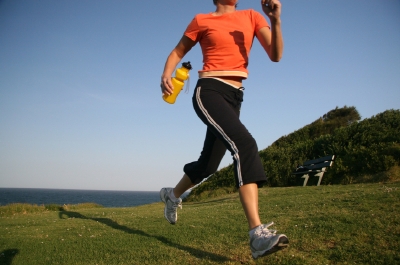
What is meant by Anaerobic?
Anaerobic is exercise that is too intense to be maintained in balance with oxygen intake. It refers to when aerobic pathways are insufficient to supply energy at the required rate, such as in a 200 yard sprint.
When a person performs anaerobic exercises, such as high intensity exercise, the muscle cells in the body have to rely on other reactions that do not require oxygen to fuel muscle contractions. This leads to fatigue.
Fatigue leads to feelings of discomfort and the weakening of the muscles. When the body becomes fatigued it will eventually need to slow down or lower the level of intensity of the exercise that is being performed, or stop exercising altogether.
For the most part the vast majority of people who exercise do so using aerobic exercises. People who are not competitive athletes who wish to exercise to gain health benefits or to lose a few extra pounds typically will perform aerobic exercises that can be done for longer periods of time, such as walking and biking.
The benefit of using aerobic exercise is that individuals are able to maintain longer periods of aerobic activity which results in more calories being burned.
Aerobic Exercise is Less Stressful for the Heart and Joints
Aerobic exercise is also less stressful on the joints, the muscles and on the heart. This can be very important to anyone with health concerns such as arthritis or high blood pressure.
But for those individuals who are looking to step up their exercise routine or to gain more endurance and strength, anaerobic exercises prove extremely helpful. Anaerobic exercises help to increase overall ability, capacity, tolerance, endurance and performance.
If you are looking to get more out of your workout and want to add some anaerobic activities but are not sure how to start don’t be afraid. The good news is that there is no special equipment needed to determine when the body makes the transition from aerobic to anaerobic.
When a person is exercising and reaches their metabolic threshold intensity the person will begin to breath harder and be forced to concentrate on the exercise more intensely. This is the time in the workout routine when the exercise becomes unpleasant and uncomfortable. That is anaerobic exercise.
Aerobic Versus Anaerobic
Anaerobic exercises will trigger anaerobic metabolism and muscles that are developed during anaerobic exercise develop differently then muscles that are built using regular aerobic exercises. This leads to greater performance levels and longer endurance periods.
Anaerobic exercises can last from anywhere between just a few seconds up to two or three minutes. These are short bursts of intense activity that can only be maintained for short periods of time. Aerobic exercises can be done for longer periods of time because they are performed at lower intensity levels.
Exercises That Are Aerobic Include:
- Cross country running
- Cycling
- Jogging
- Swimming
- Fast walking
When our bodies are at rest they will rely on aerobic metabolism to fuel them. Aerobic metabolism takes care of basically all of our bodies energy requirements. When we begin to expend more energy it causes our bodies to have a larger need for energy which requires more oxygen.
When exercise activities are increased slowly we are able to build up our endurance and we will not experience symptoms of fatigue. When a person performs anaerobic exercises they are intentionally making the body fatigued to build endurance and stamina, strength and perseverance.
Anaerobic Exercises

Any exercise that is performed at a high level of intensity which requires an energy rate production that is greater than regular aerobic exercise is considered to be an anaerobic exercise.
This level will obviously differ from individual to individual depending on their fitness level.
Some Exercises That Are Anaerobic Include:
- Sprinting
- Sprint Cycling
- Interval Training
- Heavy Weight Lifting
- Any Intense Physical Activity
During these exercises the muscles fatigue faster and the individual is not able to keep up with the activities or exercises over long periods of time. Anaerobic exercises can also include sprint running.



Be the first to comment